2015 MERCEDES-BENZ SLS AMG GT COUPE parking brake
[x] Cancel search: parking brakePage 13 of 290
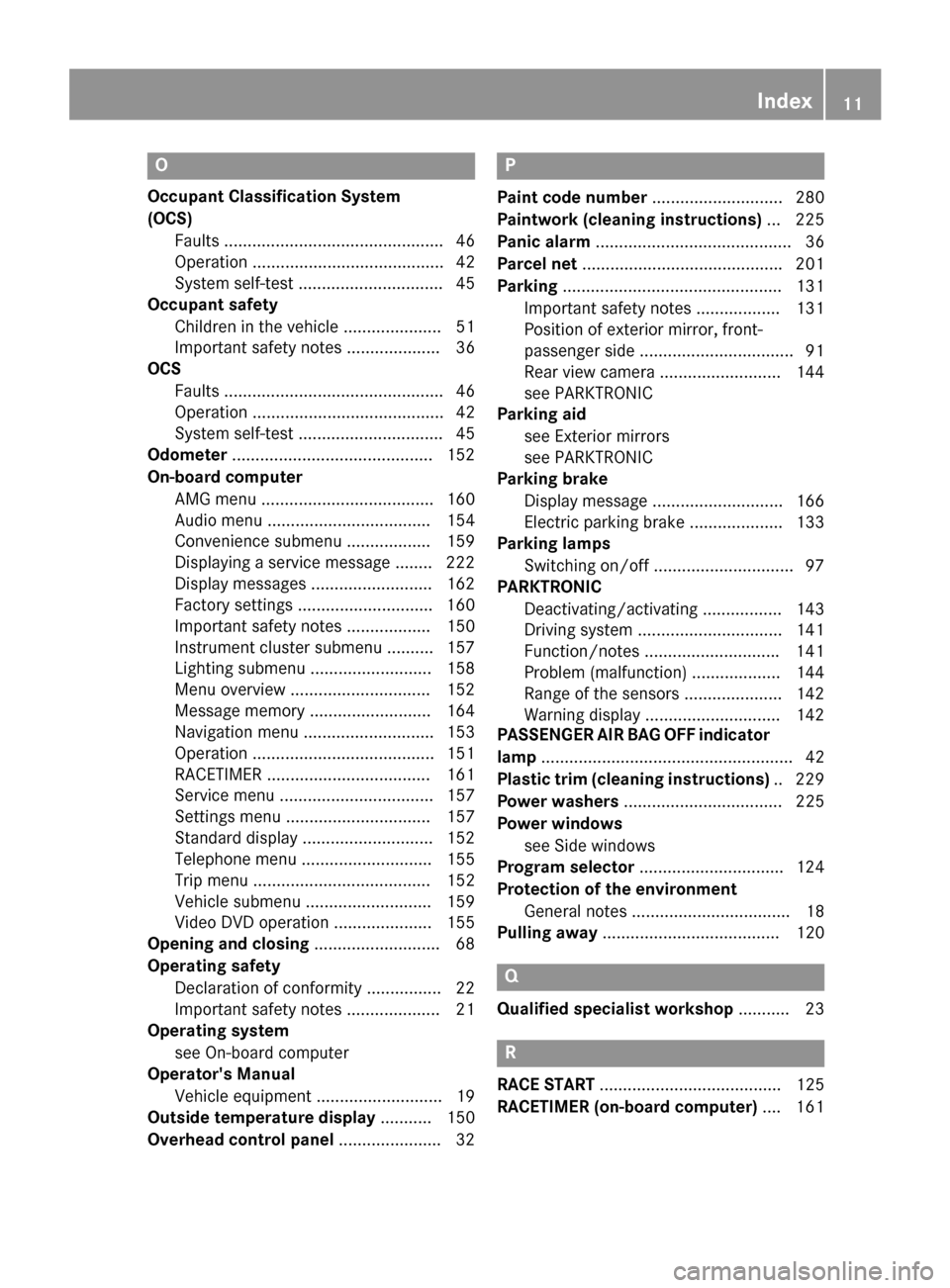
O
Occupant Classification System
(OCS) Faults ............................................... 46
Operation ......................................... 42
System self-test ...............................45
Occupant safety
Children in the vehicle ..................... 51
Important safety notes .................... 36
OCS
Faults ............................................... 46
Operation ......................................... 42
System self-test ...............................45
Odometer ...........................................1 52
On-board computer AMG menu ..................................... 160
Audi omenu ................................... 154
Convenience submenu .................. 159
Displaying aservice message ....... .222
Display messages .......................... 162
Factory settings ............................ .160
Important safety notes .................. 150
Instrument cluster submenu .......... 157
Lighting submenu .......................... 158
Menu overview .............................. 152
Message memory .......................... 164
Navigation menu ............................ 153
Operation ....................................... 151
RACETIMER ................................... 161
Service menu ................................. 157
Settings menu ............................... 157
Standard displa y............................ 152
Telephone menu ............................ 155
Trip menu ...................................... 152
Vehicle submenu ........................... 159
Video DVD operatio n..................... 155
Opening and closing ........................... 68
Operatin gsafety
Declaratio nofconformity ................ 22
Important safety notes .................... 21
Operatin gsystem
see On-board computer
Operator's Manual
Vehicle equipment ........................... 19
Outside temperature display ........... 150
Overhead control panel ......................32 P
Paint code number ............................280
Paintwork (cleaning instructions) ... 225
Pani calarm .......................................... 36
Parce lnet .......................................... .201
Parking ............................................... 131
Important safety notes .................. 131
Position of exterio rmirror, front-
passenger sid e................................. 91
Rea rview camera .......................... 144
see PARKTRONIC
Parking aid
see Exterior mirrors
see PARKTRONIC
Parking brake
Display message ............................ 166
Electric parking brake .................... 133
Parking lamps
Switching on/off .............................. 97
PARKTRONIC
Deactivating/activating ................. 143
Driving system ............................... 141
Function/notes ............................ .141
Problem (malfunction) ................... 144
Range of the sensors ..................... 142
Warning displa y............................. 142
PASSENGER AI RBAG OF Find icator
lamp ...................................................... 42
Plasti ctrim (cleaning instructions) .. 229
Powe rwashers .................................. 225
Powe rwindows
see Sid ewindows
Program selector ............................... 124
Protectio nofthe environment
Genera lnotes .................................. 18
Pulling away ...................................... 120 Q
Qualified specialist workshop ........... 23 R
RAC ESTART ....................................... 125
RACETIMER (on-board computer) .... 161 Index
11
Page 18 of 290
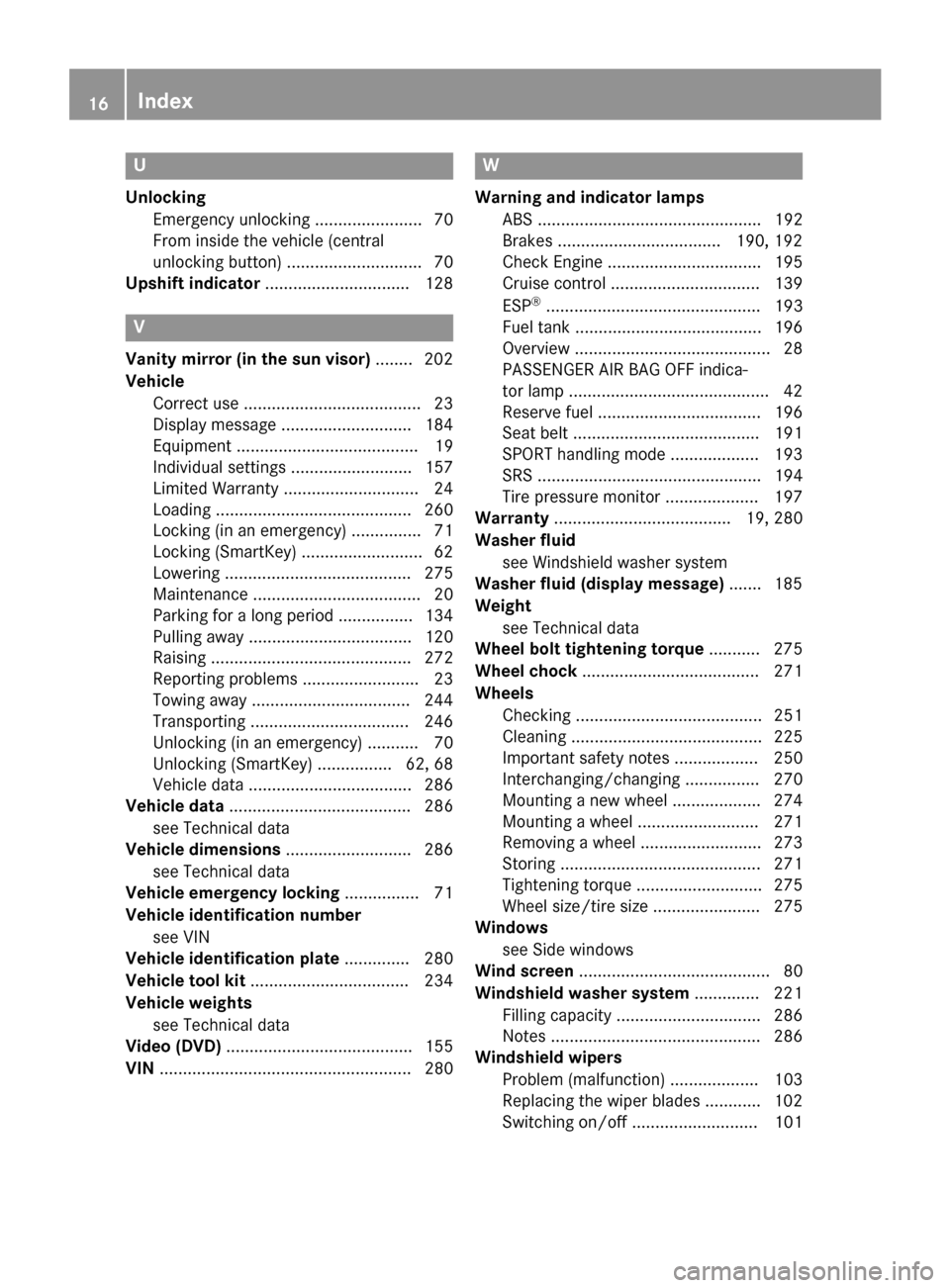
U
Unlocking Emergenc yunlocking .......................70
From inside the vehicle (central
unlocking button) ............................. 70
Upshift indicator ............................... 128V
Vanity mirror (i nthe sun visor) ........ 202
Vehicle Correct us e...................................... 23
Displa ymessag e............................ 184
Equipment ....................................... 19
Individua lsettings .......................... 157
Limite dWarranty ............................. 24
Loading .......................................... 260
Locking (i nanemergency) ............... 71
Locking (SmartKey ).......................... 62
Lowering ........................................ 275
Maintenance .................................... 20
Parking for alon gp eriod. ............... 134
Pulling away ................................... 120
Raising ........................................... 272
Reporting problems ......................... 23
Towing away .................................. 244
Transporting .................................. 246
Unlocking (i nanemergency) ........... 70
Unlocking (SmartKey )................ 62, 68
Vehicl edata. .................................. 286
Vehicl edata ....................................... 286
see Technica ldata
Vehicl edimensions ........................... 286
see Technica ldata
Vehicl eemergenc yloc king ................ 71
Vehicl eidentificatio nnumber
see VIN
Vehicl eidentificatio nplate .............. 280
Vehicl etoolkit.................................. 234
Vehicl eweigh ts
see Technica ldata
Vide o(DV D)........................................ 155
VIN ...................................................... 280 W
Warning and indicator lamps ABS ................................................ 192
Brakes ................................... 190 ,192
Check Engine ................................. 195
Cruise control ................................ 139
ESP ®
.............................................. 193
Fue ltank ........................................ 196
Overview .......................................... 28
PASSENGER AIR BAG OFF indica-
tor lamp ........................................... 42
Reserve fue l................................... 196
Sea tbelt. ....................................... 191
SPOR Thandling mod e................... 193
SRS ................................................ 194
Tire pressure monitor .................... 197
Warranty ...................................... 19, 280
Washer fluid see Windshield washe rsystem
Washer fluid (display message) ....... 185
Weight see Technical data
Wheel bolt tightenin gtorque ........... 275
Wheel chock ...................................... 271
Wheels Checking ........................................ 251
Cleaning ......................................... 225
Important safety notes .................. 250
Interchanging/changing ................ 270
Mounting anew whee l................... 274
Mounting awheel .......................... 271
Removing awheel .......................... 273
Storing ........................................... 271
Tightening torque ........................... 275
Wheel size/tire size ....................... 275
Windows
see Sid ewindows
Win dscreen ......................................... 80
Windshiel dwasher system .............. 221
Filling capacity ............................... 286
Note s............................................. 286
Windshiel dwipers
Problem (malfunction) ................... 103
Replacing the wipe rblade s............ 102
Switching on/of f........................... 101 16
Index
Page 28 of 290
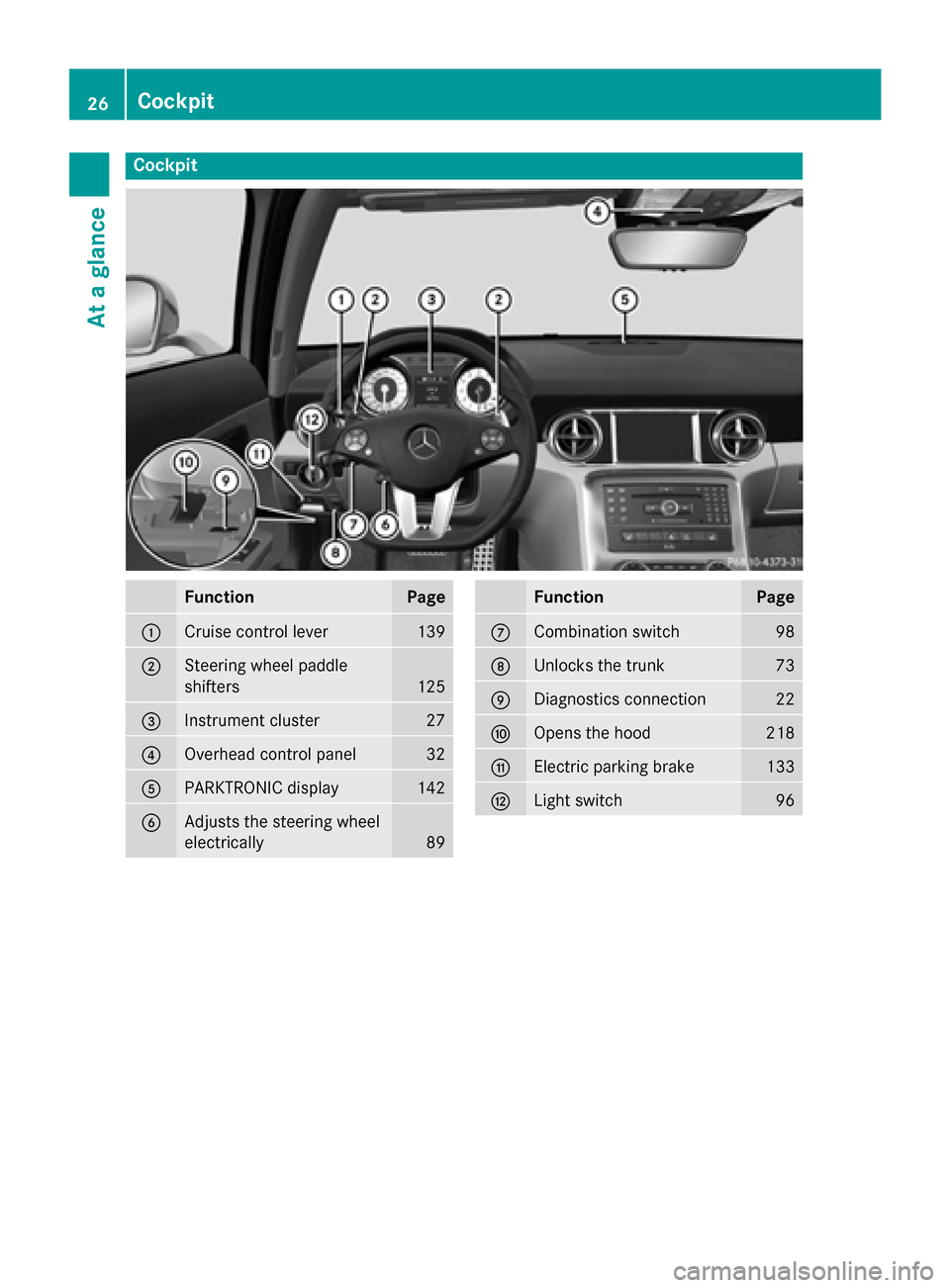
Cockpit
Function Page
0043
Cruise control lever 139
0044
Steering wheel paddle
shifters
125
0087
Instrumen
tcluster 27
0085
Overhead control panel 32
0083
PARKTRONIC display 142
0084
Adjusts th
esteering wheel
electrically 89 Function Page
006B
Combination switch 98
006C
Unlocks th
etrunk 73
006D
Diagnostics connection 22
006E
Open
sthe hood 218
006F
Electric parking brake 133
0070
Ligh
tswitch 9626
CockpitAt
ag lance
Page 30 of 290
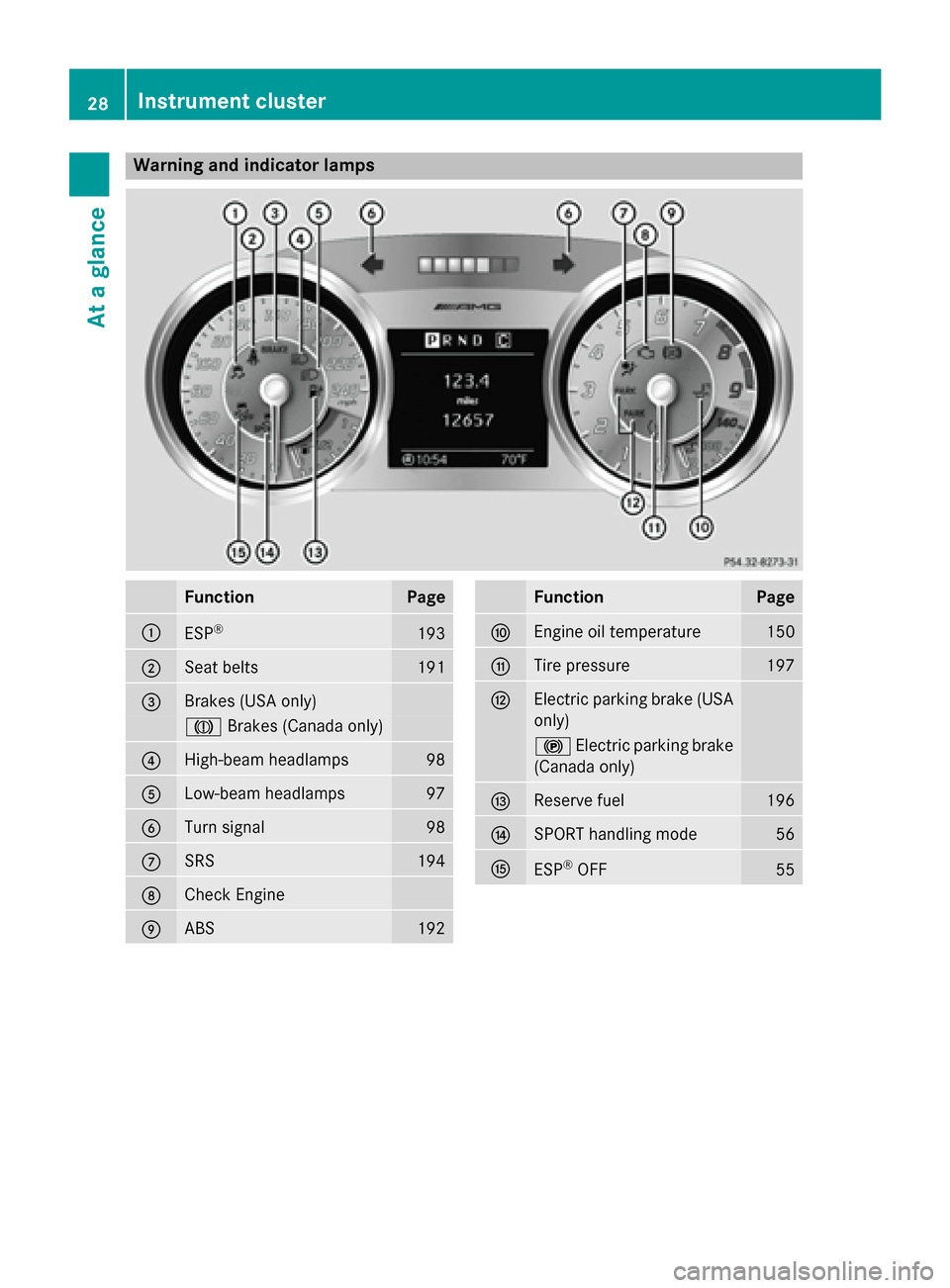
Warning and indicator lamps
Function Page
0043
ESP
® 193
0044
Seat belts 191
0087
Brakes (USA only)
004D
Brakes (Canada only) 0085
High-beam headlamps 98
0083
Low-beam headlamps 97
0084
Turn signal 98
006B
SRS 194
006C
Check Engine
006D
ABS 192 Function Page
006E
Engine oil temperature 150
006F
Tire pressure 197
0070
Electric parking brake (USA
only) 0024
Electric parking brake
(Canada only) 0071
Reserve fuel 196
0072
SPORT handling mode 56
0073
ESP
®
OFF 5528
Instrument clusterAt
ag lance
Page 57 of 290

Braking
X
If ABS intervenes: continue to depress the
brake peda lvigorously unti lthe braking sit-
uatio niso ver.
X To make afullb rake application:
depress the brake peda lwithf ullf orce.
If ABS intervenes when braking ,you will fee la
pulsing in the brake pedal.
The pulsating brake peda lcan be an indica-
tio nofh azardou sroadc onditions, and func-
tions as areminder to take extra car ewhile
driving. BAS (Brak
eAssis tSystem)
i Observ
ethe "Important safety notes "sec-
tio n(Ypage 54).
BAS operates in emergency braking situa-
tions. If yo udepress the brake peda lquickly,
BAS automaticall yboosts the braking force,
thu sshortening the stopping distance. G
WARNING
If BAS is malfunctioning ,the braking distance
in an emergency braking situatio nis
increased .There is ariskofana ccident.
In an emergency braking situation, depress
the brake peda lwithf ullf orce. ABS prevents
the wheels from locking.
The brakes will functio nasusual once you
release the brake pedal. BAS is deactivated. ESP
®
(Electroni cStability Program)
General notes i
Observ
ethe "Important safety notes "sec-
tio n(Ypage 54).
ESP ®
monitors driving stability and traction,
i.e .power transmission between the tire sand
the roa dsurface.
If ESP ®
detects tha tthe vehicl eisdeviating
from the direction desired by the driver ,one
or more wheels ar ebraked to stabilize the vehicle. The engine outpu
tisa lsom odified to
kee pthe vehicl eonthe desired course within
physical limits .ESP ®
assists the driver when
pulling away on we torslipper yroads. ESP ®
can also stabilize the vehicl eduring braking.
ETS (Electroni cTraction System) i
Observ
ethe "Important safety notes "sec-
tio n(Ypage 54).
Tractio ncontro lispartofE SP®
.
Tractio ncontro lbrakes the drive wheels indi-
viduall yifthey spin. Thi senables yo utopull
away and accelerate on slippery surfaces, for
exampl eifthe roa dsurface is slippery on one
side.
Tractio ncontro lremains active, eve nifyou
deactivate ESP ®
.
Important safety notes G
WARNING
If ESP ®
is malfunctioning ,ESP ®
is unabl eto
stabilize the vehicle. Additionally, further driv- ing safety system sare deactivated. This
increases the ris kofskidding and an accident.
Driv eonc arefully. Hav eESP®
checked at a
qualified specialist workshop.
! Switch the ignition off when:
R the electri cparking brake is being tested
using abrake dynamometer.
R the vehicl eisbeing towed with the rear
axl eraised.
Application of the brakes by ESP ®
ma yoth-
erwis edestro ythe brake system.
Whe nSPOR Thandling mod eisactivated ,the
0074 warning lamp lights up in the instrument
panel.
Whe nESP®
is deactivated ,the 00BB and
0089 warning lamps light up in the instrument
panel.
Observ ethe informatio nonwarning lamps
(Y page 193 )and display messages which Driving safety systems
55Safety Z
Page 70 of 290
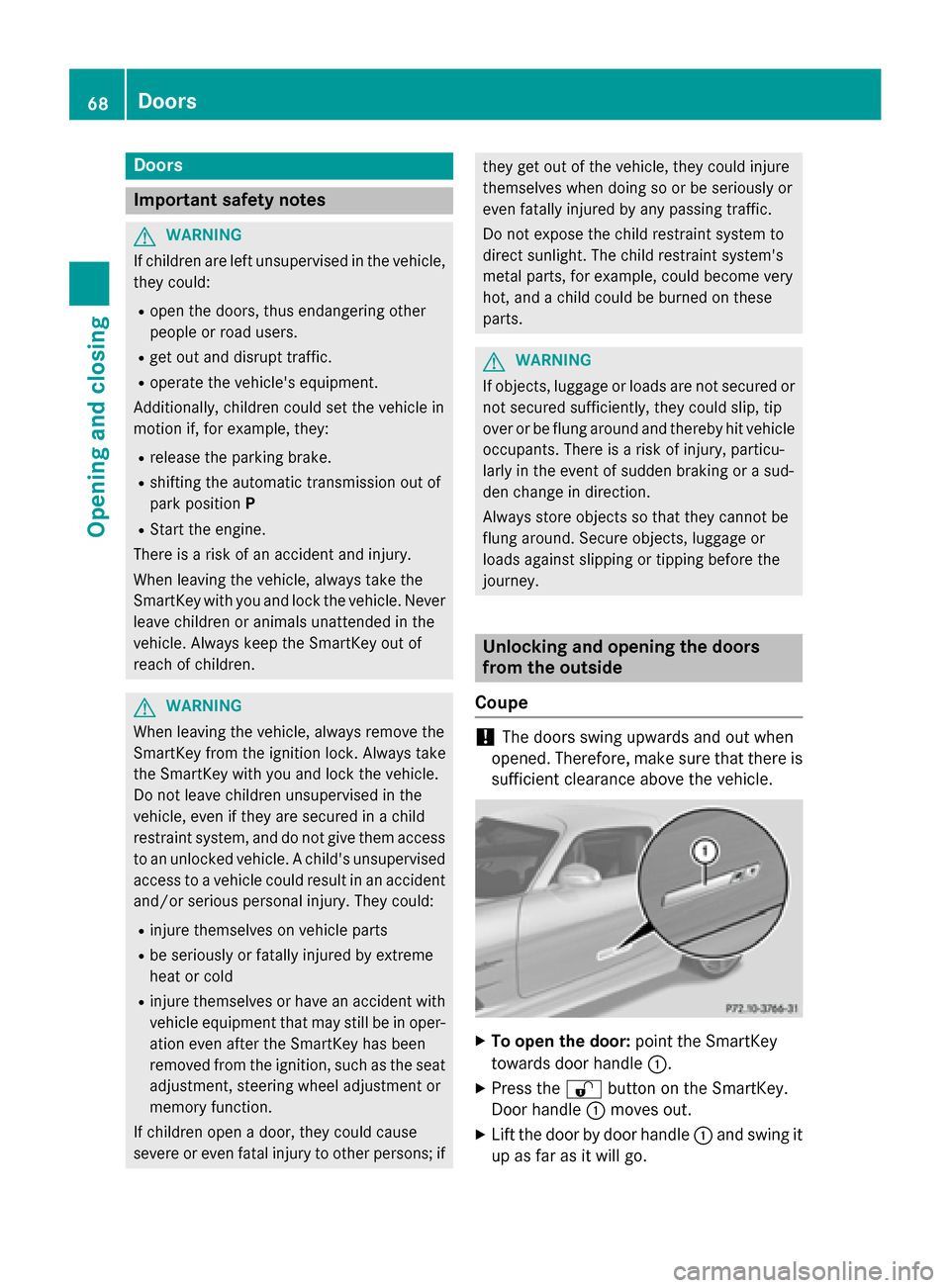
Doors
Important safet
ynotes G
WARNING
If children are lef tunsupervised in th evehicle,
they could:
R ope nthe doors ,thu se ndangerin gother
people or road users.
R get out and disrup ttraffic.
R operat ethe vehicle' sequipment.
Additionally, children could set th evehicle in
motion if, fo rexample, they:
R release th eparking brake.
R shiftin gthe automatic transmissio nout of
par kposition P
R Start th eengine.
There is ariskofana ccidentand injury.
Whe nleavin gthe vehicle, always take the
SmartKey wit hyou and loc kthe vehicle. Never
leav echildren or animals unattended in the
vehicle. Always keep th eSmartKey out of
reach of children. G
WARNING
Whe nleavin gthe vehicle, always remov ethe
SmartKey from th eignition lock. Always take
th eS martKey wit hyou and loc kthe vehicle.
Do no tleav echildren unsupervised in the
vehicle, eve niftheya re secure dinachild
restrain tsystem, and do no tgivet he ma ccess
to an unlocke dvehicle. Achild' su nsupervised
access to avehicle could result in an accident
and/o rserious personal injury. The ycould:
R injure themselves on vehicle parts
R be seriously or fatally injured by extreme
heat or cold
R injure themselves or hav eanacciden twith
vehicle equipmen ttha tm ay still be in oper-
ation eve nafter th eSmartKey has been
removed from th eignition ,suc hast heseat
adjustment, steerin gwhee ladjustmen tor
memor yfunction.
If children ope nadoor, they could cause
severe or eve nfatal injury to other persons; if they get out of th
evehicle, they could injure
themselves when doin gsoorbeseriously or
eve nfatally injured by any passin gtraffic.
Do no texposet he child restrain tsystem to
direc tsunlight. The child restrain tsystem's
metal parts ,for example, could becom every
hot ,and achild could be burne donthese
parts. G
WARNING
If objects ,luggage or load sare no tsecure dor
no tsecure dsufficiently, they could slip ,tip
over or be flun garound and thereby hit vehicle
occupants. There is ariskofi njury, particu-
larl yint he event of sudden braking or asud-
den chang eindirection.
Always stor eobjects so that they canno tbe
flun garound .Secureo bjects ,luggage or
load sagainst slippin gortippin gb efor ethe
journey. Unlockin
gand opening th edoors
from th eoutside
Coupe !
The doors swin
gupwards and out when
opened. Therefore, mak esuret hatthe re is
sufficien tclearanc eabov ethe vehicle. X
To ope nthe door: pointthe SmartKey
toward sdoorh andle 0043.
X Press the 0036buttonont heSmartKey.
Door handle 0043moves out.
X Lif tthe doo rbyd oorh andle 0043and swin git
up as far as it will go. 68
DoorsOpening an
dclosing
Page 120 of 290
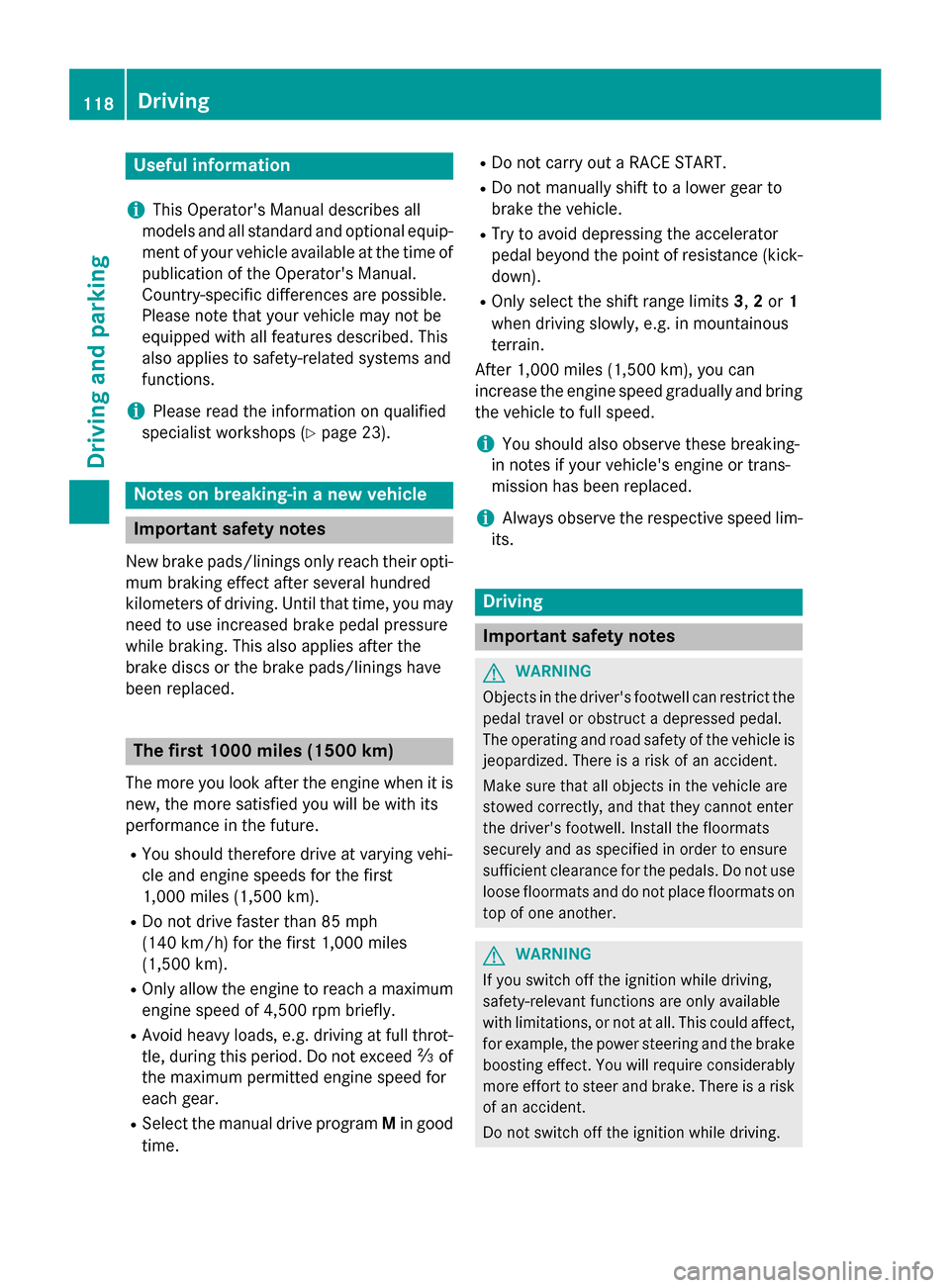
Useful information
i This Operator's Manual describes all
models and all standard and optional equip- ment of your vehicle available at the time of
publication of the Operator's Manual.
Country-specific differences are possible.
Please not ethat your vehicle may not be
equipped with all feature sdescribed. This
also applies to safety-related system sand
functions.
i Please read the information on qualified
specialist workshops (Y page 23).Notes on breaking-in
anew vehicle Important safet
ynotes
New brake pads/linings only reach their opti-
mum brakin geffec tafter several hundred
kilometers of driving. Until that time, you may
need to use increased brake pedal pressure
while braking. This also applies after the
brake discs or the brake pads/linings have
been replaced. The first 1000 miles (1500 km)
The more you look after the engin ewhen it is
new, the more satisfied you will be with its
performanc einthe future.
R You should therefore drive at varying vehi-
cle and engin espeeds for the first
1,00 0miles (1,50 0km).
R Do not drive faster than 85 mph
(140 km/h) for the first 1,00 0miles
(1,50 0km).
R Only allow the engin etoreach amaximum
engin espeed of 4,50 0rpm briefly.
R Avoid heavy loads, e.g. drivin gatfull throt-
tle, during this period. Do not exceed 00C3of
the maximum permitted engin espeed for
each gear.
R Selec tthe manual drive program Min good
time. R
Do not carry out aRACE START.
R Do not manually shift to alower gear to
brake the vehicle.
R Try to avoid depressin gthe accelerator
pedal beyond the point of resistance (kick-
down).
R Only select the shift range limits 3,2or 1
when drivin gslowly, e.g. in mountainous
terrain.
After 1,00 0miles (1,500 km), you can
increase the engin espeed gradually and bring
the vehicle to full speed.
i You should also observ
ethes ebreaking-
in notes if your vehicle' sengin eort rans-
mission has been replaced.
i Always observ
ethe respective speed lim-
its. Driving
Important safet
ynotes G
WARNING
Objects in the driver's footwell can restrict the pedal travel or obstruct adepressed pedal.
The operatin gand road safet yofthe vehicle is
jeopardized. There is arisk of an accident.
Make sure that all objects in the vehicle are
stowed correctly, and that they cannot enter
the driver' sfootwell. Install the floormats
securely and as specified in order to ensure
sufficient clearance for the pedals. Do not use loose floormats and do not place floormats on
top of one another. G
WARNING
If you switc hoff the ignition while driving,
safety-relevant function sare only available
with limitations, or not at all. This could affect, for example, the power steering and the brake
boosting effect. You will require considerably
more effor ttosteer and brake. There is arisk
of an accident.
Do not switc hoff the ignition while driving. 118
DrivingDriving and parking
Page 121 of 290
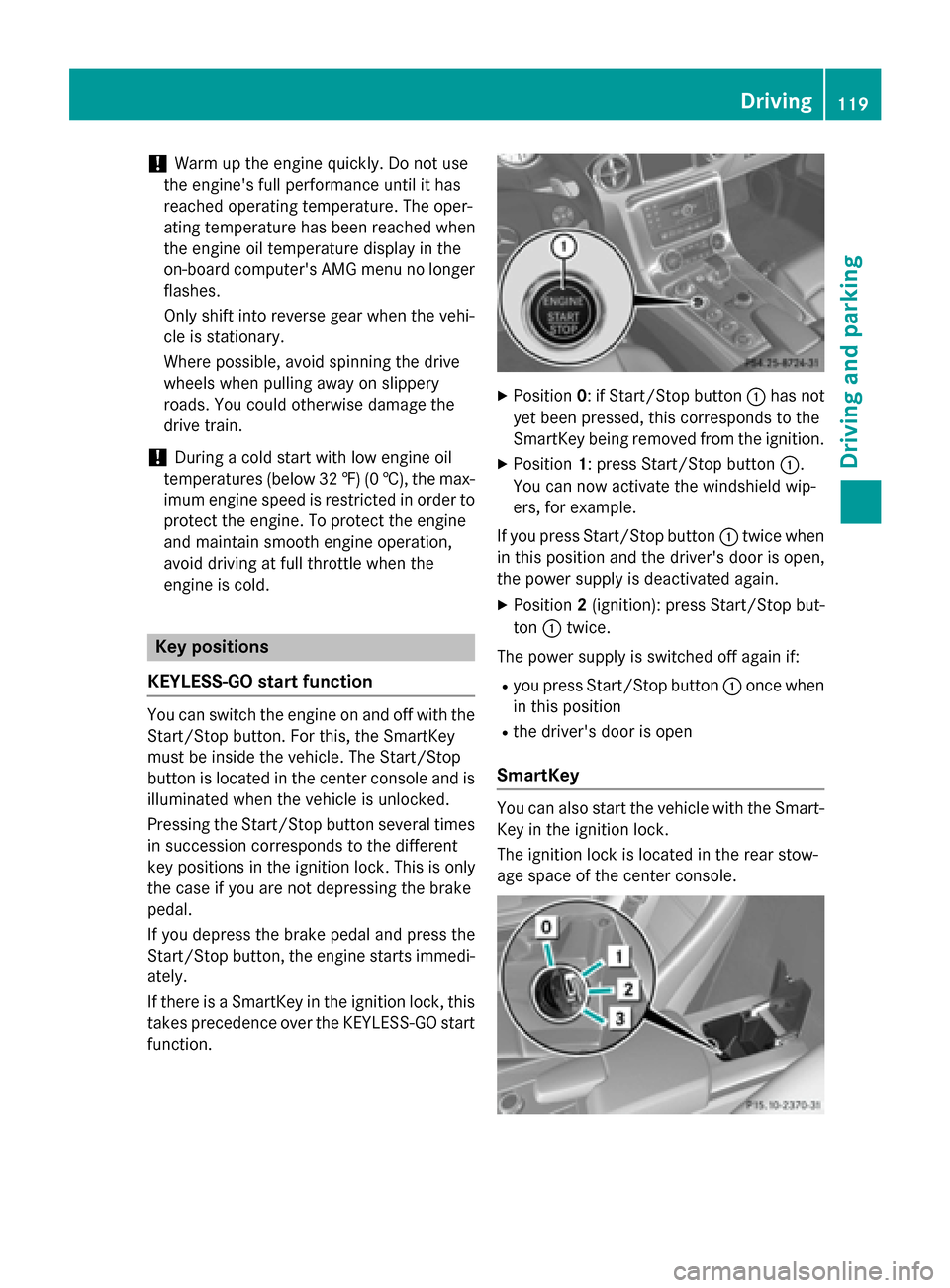
!
Warm up the engine quickly. Do not use
the engine's full performance until it has
reached operating temperature. The oper-
ating temperature has been reached when
the engine oil temperature displayint he
on-board computer's AMG menu no longer flashes.
Only shift into reverse gear when the vehi-
cle is stationary.
Where possible, avoid spinning the drive
wheels when pulling awayons lippery
roads. You could otherwise damage the
drive train.
! During
acold start with low engine oil
temperatures (below 32 ‡) (0 †), the max- imum engine speed is restricted in order toprotect the engine. To protect the engine
and maintain smooth engine operation,
avoid driving at full throttle when the
engine is cold. Key positions
KEYLESS-GO start function You can switch the engine on and off with the
Start/Stop button. For this, the SmartKey
must be inside the vehicle. The Start/Stop
button is located in the center console and is
illuminated when the vehicle is unlocked.
Pressing the Start/Stop button several times
in succession corresponds to the different
key positions in the ignition lock. This is only
the case if you are not depressing the brake
pedal.
If you depress the brake pedal and press the
Start/Stop button, the engine starts immedi-
ately.
If there is aSmartKey in the ignition lock, this
takes precedence over the KEYLESS-GO start
function. X
Position 0:ifStart/Stop button 0043has not
yet been pressed, this corresponds to the
SmartKey being removed from the ignition.
X Position 1:press Start/Stop button 0043.
You can now activate the windshieldw ip-
ers, for example.
If you press Start/Stop button 0043twice when
in this position and the driver's door is open,
the power supplyisd eactivated again.
X Position 2(ignition): press Start/Stop but-
ton 0043twice.
The power supplyiss witched off againif:
R you press Start/Stop button 0043once when
in this position
R the driver's door is open
SmartKey You can also start the vehicle with the Smart-
Key in the ignition lock.
The ignition lock is located in the rear stow-
age space of the center console. Driving
119Driving and parking Z